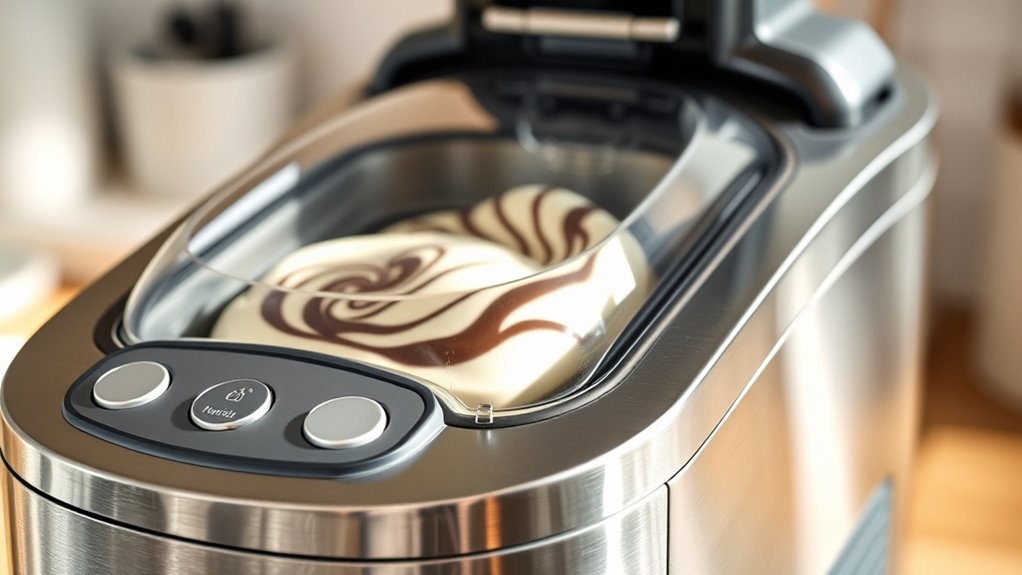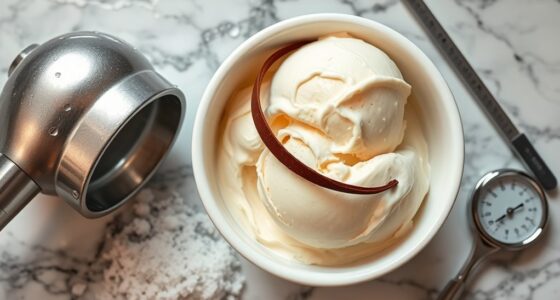To guarantee your ice cream maker is safe, check that it has proper safety certifications like UL or CE, and inspect the power cord for damage. Make sure all parts are assembled correctly and fittings are tight to prevent leaks. Regularly monitor for overheating or unusual noises, and clean the machine thoroughly after each use. Avoid using expired ingredients and store your appliance properly when not in use. Keep these tips in mind as you continue exploring how to stay safe.
Key Takeaways
- Check for safety certifications like UL, CE, or CSA to ensure compliance with safety standards.
- Inspect electrical cords and components regularly for damage or wear to prevent shocks or fires.
- Follow manufacturer’s assembly instructions carefully and ensure all parts are securely fitted before use.
- Clean and dry all components thoroughly after each use, and store in a cool, dry place to prevent mold and damage.
- Use fresh ingredients, handle raw foods properly, and adhere to manufacturer guidelines for safe operation.
Check the Manufacturer’s Safety Certifications
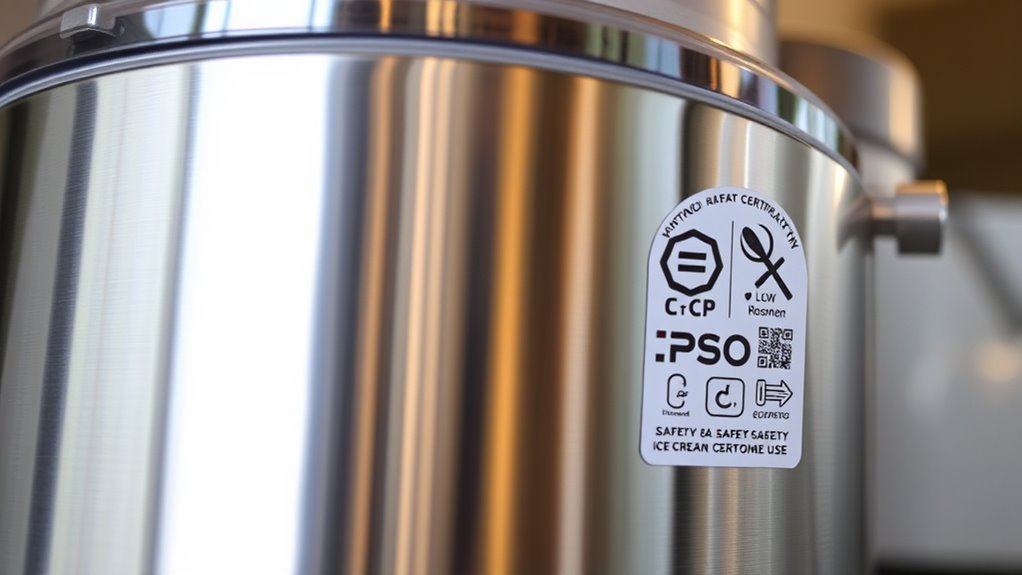
Before purchasing an ice cream maker, you should verify that the manufacturer has obtained proper safety certifications. Checking for product certifications ensures the appliance meets established safety standards, reducing the risk of electrical hazards or malfunctions. Reputable brands typically display certification labels from recognized organizations like UL, CE, or CSA on their products or packaging. These certifications indicate that the device has been tested for safety and complies with industry regulations. Don’t overlook this step, as it’s a key indicator of quality and safety. By confirming the presence of proper safety standards and certifications, you protect yourself and your household from potential accidents or faulty equipment. Always prioritize certified products to ensure your ice cream maker is safe to use daily.
Inspect the Power Cord and Electrical Components
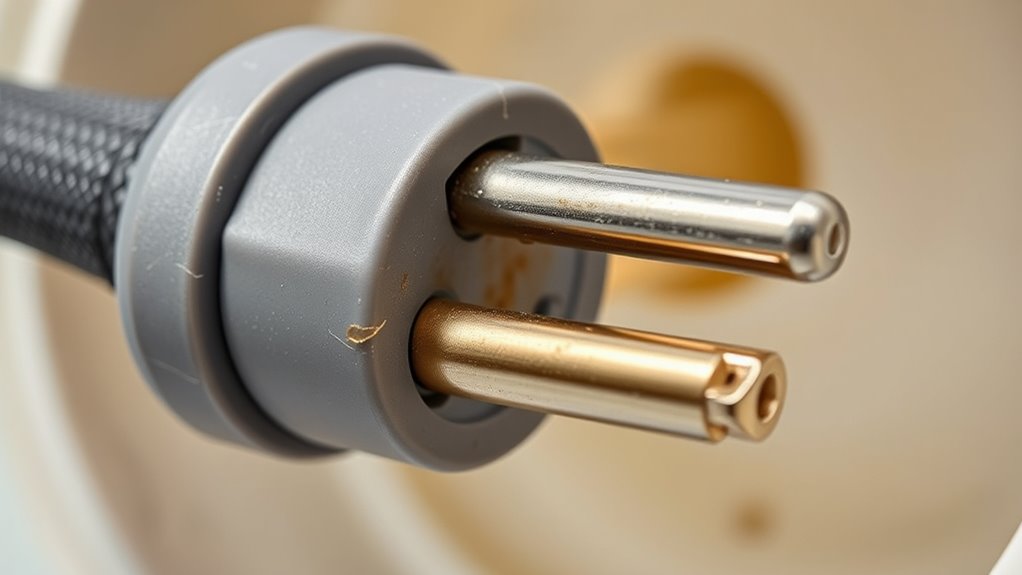
Have you checked the power cord and electrical components for damage? Power cord inspection is essential for electrical safety. Damaged cords can cause shocks or fires, so verify they are intact. Here are three key steps:
- Inspect the entire length of the cord for cuts, frays, or exposed wires.
- Check the plug for bent or broken prongs and verify it fits securely.
- Examine electrical components for burn marks, corrosion, or loose connections. Regular electrical safety checks help prevent accidents and extend your appliance’s life. Additionally, ensure that the sound vibrations and other features of your appliance are functioning properly. If you notice any issues, stop using the ice cream maker immediately and replace damaged parts. Never ignore signs of wear, as electrical faults pose a serious safety risk. Prioritize power cord inspection to keep your ice cream making safe and enjoyable. Maintaining proper electrical connections can also prevent potential malfunctions and prolong your appliance’s lifespan.
Ensure Proper Assembly and Secure Fittings
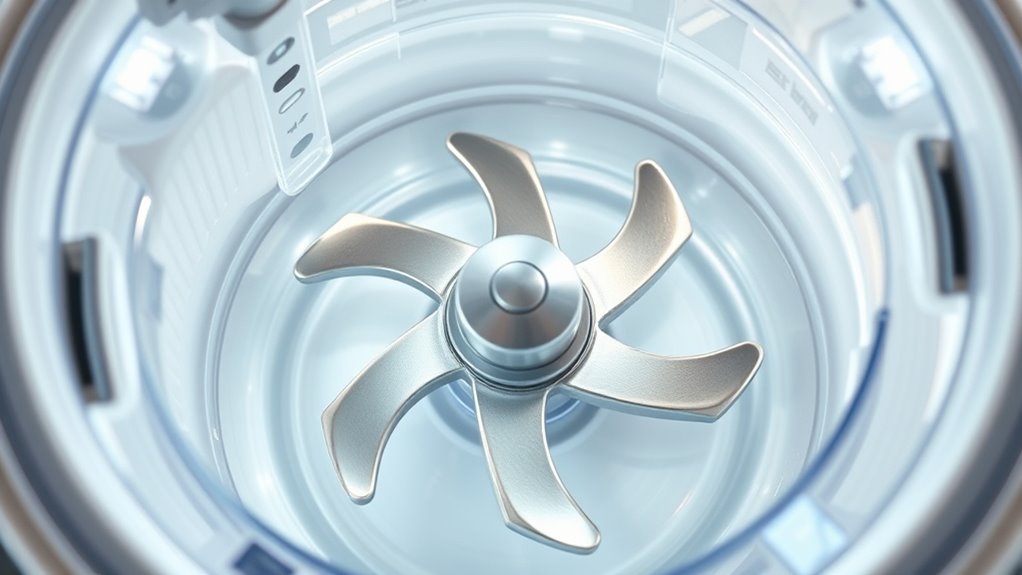
Make sure you follow the assembly instructions carefully to avoid mistakes. Tighten all fittings securely to prevent leaks or accidents. Always test the machine briefly before use to confirm everything is properly assembled and safe to operate. Additionally, inspecting the machine for any assembly errors can help ensure safe and effective operation. Regularly checking hoses and nozzles for wear can prevent malfunctions during operation. For optimal performance, consider consulting performance upgrades to enhance efficiency and reliability. Staying informed about automation in business can also provide insights into improving your appliance’s features and functionality. Proper maintenance and understanding of filtering systems can also contribute to the longevity and safety of your ice cream maker.
Check Assembly Instructions
Ensuring that you carefully follow the assembly instructions is essential for the safe operation of your ice cream maker. Your user manual provides step-by-step guidance to prevent assembly safety issues. To make sure everything is correct, double-check the following:
- Read the entire user manual before starting assembly to understand all safety precautions.
- Follow each step precisely, ensuring all parts fit securely and correctly.
- Confirm that all fittings are properly aligned and locked into place, avoiding loose components.
Tighten All Fittings
To guarantee your ice cream maker operates safely and efficiently, it’s essential to tighten all fittings properly during assembly. Loose clamp fittings can cause leaks, risking electrical issues or messes. Check that sealing gaskets are seated correctly to prevent air or liquid leaks. Use a wrench or your hands to firmly secure fittings without over-tightening, which could damage components. Keep an eye on these key parts:
| Fitting Type | Proper Tightening Tip | Common Issue |
|---|---|---|
| Clamp fittings | Tighten until snug, avoid overdoing | Leaks or detachment |
| Sealing gaskets | Ensure they sit evenly and firmly | Leaks or reduced efficiency |
| Connections | Confirm all connections are secure | System malfunction or leaks |
Always double-check fittings before operation to ensure safety and efficient performance.
Test Before Use
Before operating your ice cream maker, it’s important to verify that all fittings are properly assembled and secure. This ensures no leaks or malfunctions during use, preserving ingredient quality and ice cream flavor. To test before use:
- Check that the lid and bowl are tightly fitted to prevent air leaks that could affect texture.
- Run the machine briefly without ingredients to listen for unusual noises, confirming everything is properly aligned.
- Inspect the seals and gaskets for wear, replacing any damaged parts to maintain hygiene and safety.
- Regularly monitor the AI safety measures within your appliances to ensure they are functioning correctly and securely.
- Additionally, verifying the proper assembly of all components helps prevent potential safety hazards during operation.
- Confirm that all secure fittings are tight, especially if the machine has been moved or cleaned recently, to ensure optimal performance.
- Reviewing asset division laws can also be helpful if your appliance was part of a larger property settlement, ensuring proper legal handling.
- Properly functioning filtration systems in your appliances can also help maintain overall safety and performance.
Performing these steps guarantees your ice cream maker functions correctly, safeguarding ingredient quality and ensuring the best flavor. Proper assembly and secure fittings are essential for safe, delicious ice cream every time.
Test for Overheating or Unusual Noises
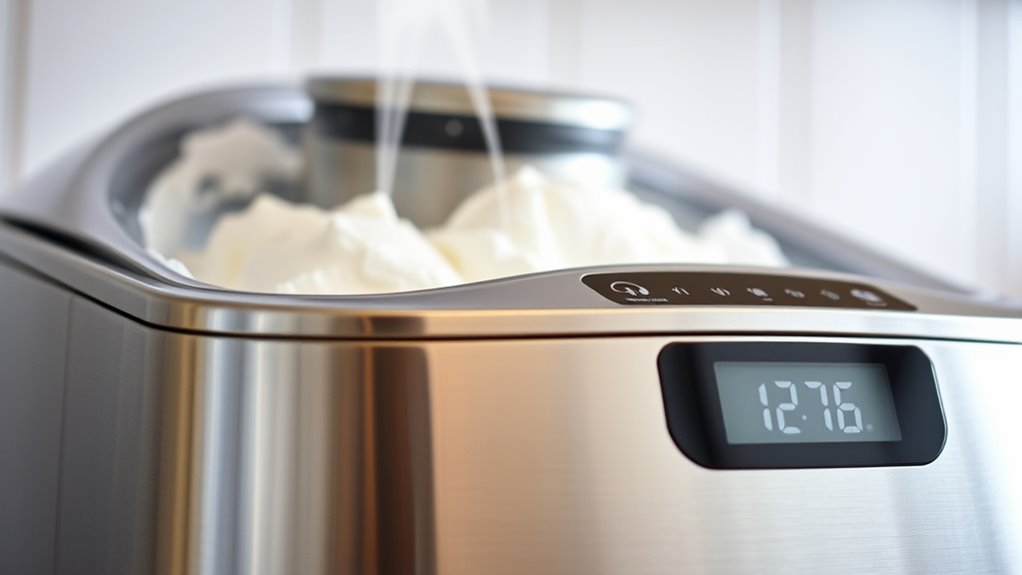
When testing your ice cream maker, pay close attention to any signs of overheating or unusual noises during operation. Check the cooling system to verify it’s functioning properly; if it feels excessively hot or the machine shuts down unexpectedly, it may indicate a problem. Listen carefully to the noise levels—loud, grinding, or irregular sounds could signal mechanical issues or worn components. Overheating can damage the motor or other parts, so monitor temperature and listen for any strange sounds that don’t match normal operation. If you notice any signs of overheating or unusual noises, stop using the machine immediately and inspect it further. Addressing these issues early helps prevent damage and ensures your ice cream maker remains safe and reliable. Additionally, regular maintenance and tuning of your appliance can help maintain optimal performance and longevity. Regularly checking performance cookies can also give you insights into how well your appliance is functioning over time. Inadequate ventilation can also cause overheating, so ensure the machine is placed in a well-ventilated area.
Follow Proper Cleaning and Sanitization Procedures
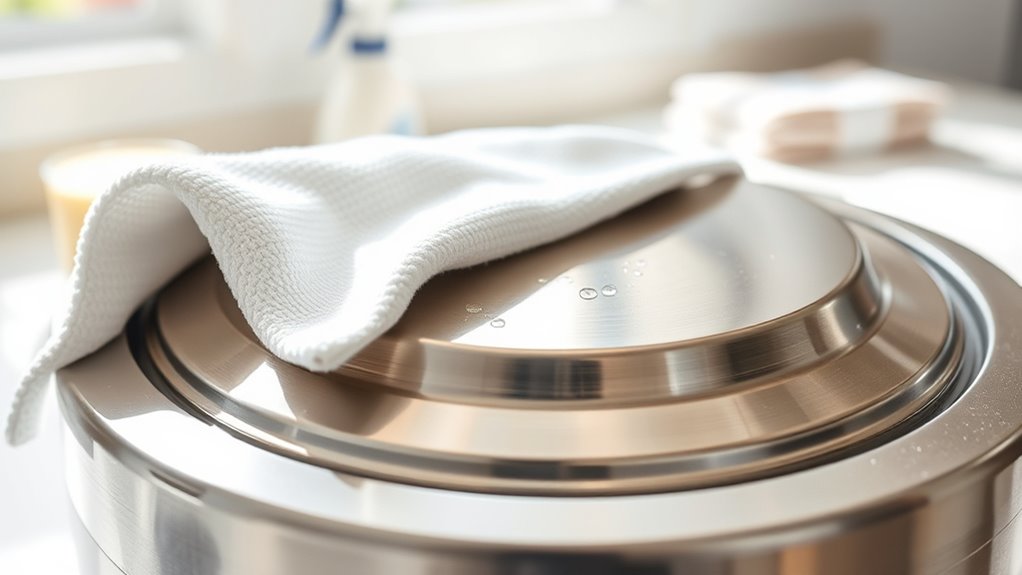
To keep your ice cream maker safe, you need to follow proper cleaning and sanitization steps. Make sure to wash all components thoroughly and use the right sanitizers to kill bacteria. Always dry everything completely before using the machine again to prevent contamination. Using appropriate sanitization procedures can further ensure the safety and hygiene of your appliance. Regular maintenance, such as inspecting for clogged filters, can also help prevent issues and maintain optimal performance. Additionally, understanding Bitcoin IRA management strategies can provide insight into secure handling of digital assets, emphasizing the importance of proper safeguarding measures. Incorporating proper hygiene practices during cleaning routines can significantly reduce the risk of bacterial growth and ensure your ice cream remains safe to enjoy. Furthermore, paying attention to the effectiveness of cleaning methods helps guarantee that all residues and bacteria are properly eliminated from your equipment.
Wash Components Thoroughly
Always wash ice cream maker components thoroughly after each use to prevent bacterial growth and cross-contamination. Proper cleaning guarantees your dairy storage remains safe and helps maintain flavor consistency. Follow these steps to keep your machine in top shape:
- Rinse all parts with warm water immediately after use to remove residual dairy and prevent buildup.
- Use a mild soap or designated cleaner, scrubbing all surfaces, especially crevices, to eliminate bacteria.
- Dry components completely before reassembling to avoid moisture that can spoil dairy and affect flavor.
Use Proper Sanitizers
After thoroughly washing your ice cream maker components, the next step is to use proper sanitizers to eliminate any remaining bacteria. Choosing a sanitizer with high sanitizer effectiveness is essential to guarantee your equipment stays bacteria-free. Follow the manufacturer’s instructions for dilution and contact time to maximize effectiveness. Remember, cleaning frequency matters—sanitize after every use to prevent bacterial buildup. Regular sanitization not only protects your health but also extends your ice cream maker’s lifespan. Avoid shortcuts by skipping this step, as bacteria can thrive if sanitizers aren’t used properly. Always use food-safe sanitizers approved for kitchen equipment, and guarantee all parts are coated thoroughly. Proper sanitization is a simple but critical step in keeping your ice cream maker safe and your treats delicious.
Dry Completely Before Use
Ensuring your ice cream maker parts are completely dry before use is a crucial step in maintaining food safety and equipment longevity. Moisture control prevents mold growth and preserves the integrity of your machine. Proper drying also minimizes the risk of bacteria buildup caused by residual moisture from storage conditions. To ensure thorough dryness, follow these steps:
- Wipe all parts with a clean towel and air dry for at least 30 minutes.
- Store parts in a cool, dry place to prevent moisture accumulation.
- Check for any remaining dampness before reassembling or using the machine.
Use the Correct Ingredients and Avoid Cross-Contamination
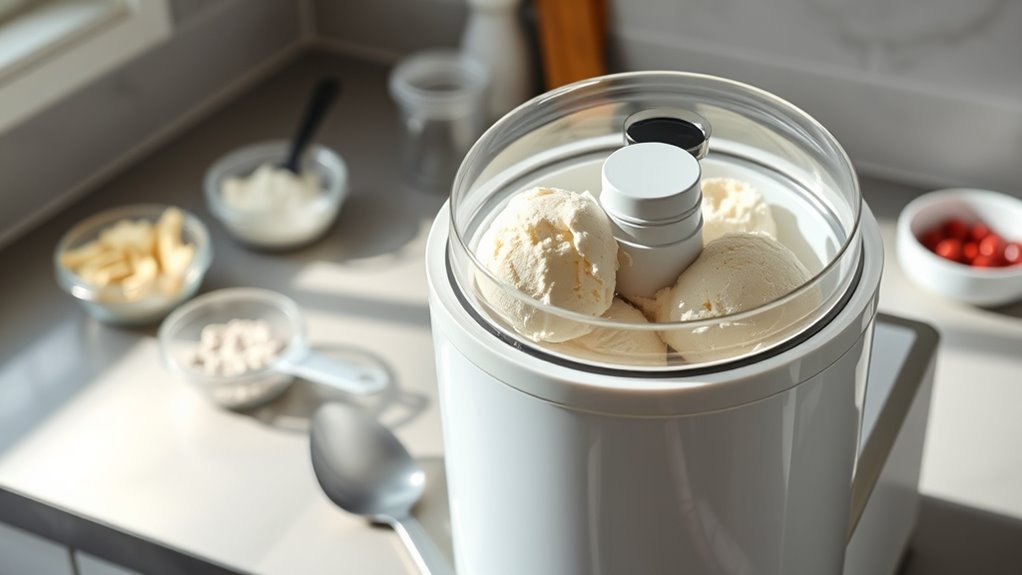
Using the correct ingredients is essential for both the safety and quality of your ice cream. Always choose fresh, high-quality ingredients to guarantee ingredient safety and prevent contamination. Avoid using expired dairy or contaminated fruits, as these can cause foodborne illnesses. Cross-contamination can occur if raw ingredients touch other foods or utensils. To minimize risks, follow proper hygiene practices and keep ingredients separate. Use the table below to highlight common sources of contamination and their prevention:
| Source | Risk | Prevention |
|---|---|---|
| Raw dairy | Bacterial contamination | Use pasteurized products |
| Unwashed produce | Pathogen transfer | Wash thoroughly before use |
| Shared utensils | Cross-contamination | Use separate utensils for raw and cooked ingredients |
| Improper storage | Spoilage and bacteria | Store ingredients at correct temperatures |
Store the Ice Cream Maker Safely When Not in Use
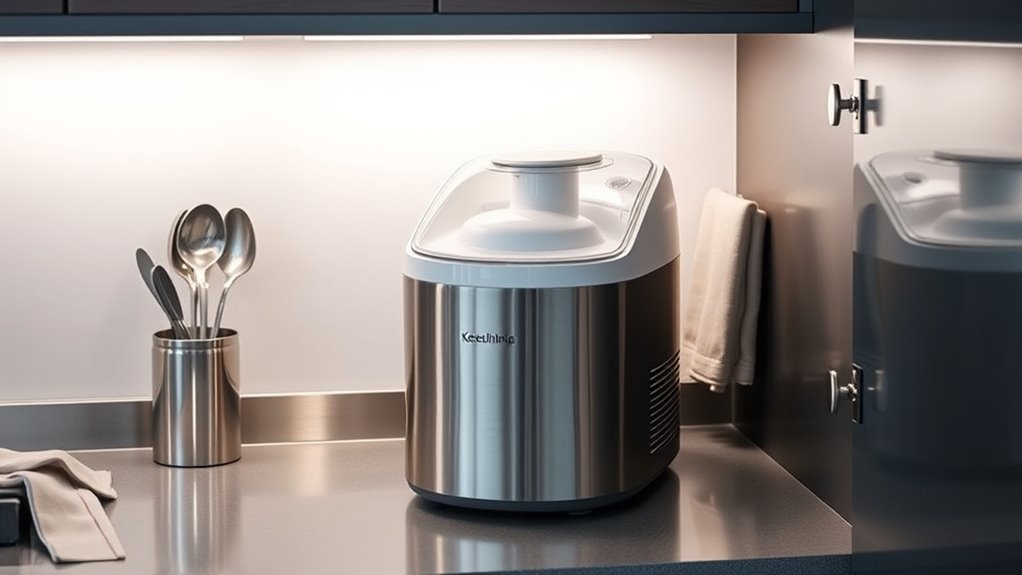
To keep your ice cream maker in good condition and safe to use, it’s important to store it properly when not in use. Proper storage precautions can extend its shelf life and prevent damage. First, clean all parts thoroughly and ensure they are completely dry to avoid mold or corrosion. Second, store the appliance in a cool, dry place away from direct sunlight and extreme temperatures, which can degrade materials. Lastly, cover the machine with a soft cloth or the original packaging to protect it from dust and debris. By following these storage precautions, you guarantee your ice cream maker remains safe and functional. Remember, proper storage not only preserves its shelf life but also guarantees safe, delicious ice cream whenever you’re ready to use it again.
Be Aware of Age and Wear of the Appliance

As your ice cream maker ages, it’s important to regularly inspect it for signs of wear and tear. Age-related issues can compromise safety and performance, so check for cracks, frayed cords, or loose parts. Wear and tear from frequent use can cause motor problems or leaks. Keep an eye on these indicators to prevent accidents or malfunctions. Use the table below to identify common age-related issues and their risks:
| Issue | Risk |
|---|---|
| Cracked housing | Electrical shock |
| Frayed power cord | Fire hazard |
| Worn-out seals | Leaks, contamination |
| Motor overheating | Appliance failure |
Regular maintenance and early detection keep your appliance safe and working efficiently.
Adhere to the Manufacturer’s Operating Instructions

Following the manufacturer’s operating instructions is vital to guarantee your ice cream maker functions safely and effectively. User manuals provide essential guidance on safety features, proper setup, and operation. Ignoring these instructions can lead to malfunctions or safety hazards. To guarantee safe use, consider these steps:
Always follow the manufacturer’s instructions for safe and effective ice cream maker use.
- Read the user manual thoroughly before first use to understand safety features and proper handling.
- Follow recommended assembly and cleaning procedures to prevent damage or accidents.
- Pay attention to safety warnings and avoid bypassing or disabling safety features.
Frequently Asked Questions
Can I Use My Ice Cream Maker Outdoors Safely?
You can use your ice cream maker outdoors, but you need to contemplate outdoor safety and weather conditions. Make sure to operate it on a flat, stable surface away from direct sunlight, rain, or moisture. Avoid using it in extreme temperatures or windy weather that could cause accidents. Check your maker’s manual for specific outdoor safety instructions, and always supervise its use to prevent damage or safety hazards.
Are There Specific Storage Conditions to Prevent Mold Growth?
To prevent mold growth, you should focus on proper storage hygiene and ideal conditions. Always clean your ice cream maker thoroughly after each use, removing any leftover ingredients. Store it in a cool, dry place with the lid slightly open to allow airflow. Avoid humid environments, as they promote mold prevention issues. Following these storage tips keeps your machine safe, clean, and ready for delicious treats anytime.
How Often Should I Replace Parts for Safety?
You should replace parts for safety according to the manufacturer’s guidelines, typically every 1-2 years or as needed. Regular part replacement ensures your ice cream maker operates safely and efficiently. Follow safety guidelines closely, inspecting parts like the blades, seals, and cords regularly. If you notice any damage or wear, don’t delay replacing those parts to prevent accidents or contamination. Staying proactive with part replacement keeps your machine safe and your treats delicious.
Is It Safe to Use Homemade or Natural Ingredients?
Imagine using homemade ice cream with fresh ingredients, like farm-fresh milk and organic fruit. This can be safe if you prioritize food safety and ingredient freshness, but always guarantee proper hygiene and storage. Using natural ingredients is great, but you must handle them carefully to prevent bacteria growth. Regularly clean your ice cream maker and verify ingredient freshness to enjoy safe, delicious treats without risking foodborne illness.
What Precautions if I Have Small Children Around the Machine?
When you have small children around your ice cream machine, it’s vital to follow child proofing tips. Keep the machine out of reach and make certain cords are secured to prevent pulling. Place it on a stable, low surface away from high traffic areas. Supervise children closely during use, and explain that the machine is not a toy. These precautions help prevent accidents and keep your little ones safe.
Conclusion
Worried about safety? Just follow these simple steps, and you’ll enjoy delicious ice cream without risks. Even if you think your machine is old, proper maintenance and careful use can keep it secure for years. Don’t let concerns stop you—taking a few minutes to inspect and clean ensures peace of mind. So go ahead, make your favorite ice cream confidently, knowing you’ve done everything to keep it safe and fun for everyone!
